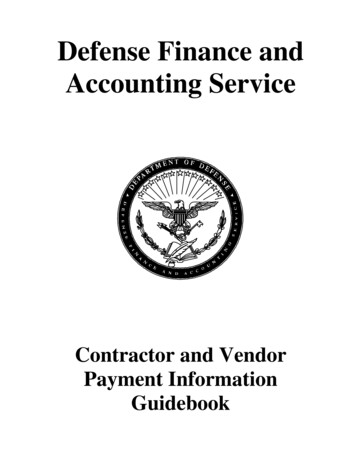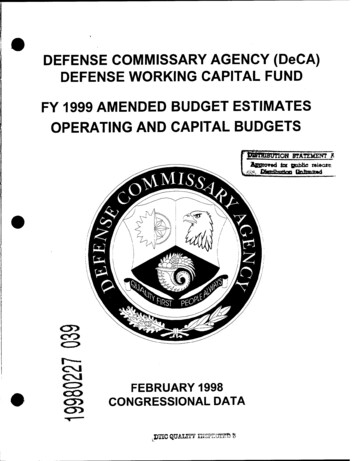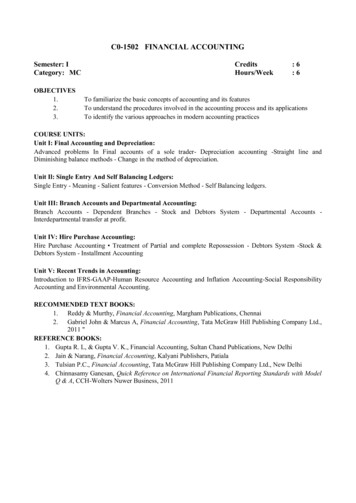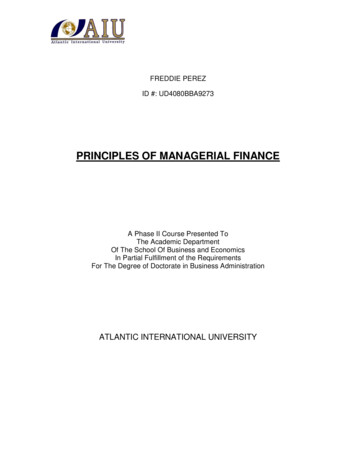
Transcription
Defense Finance andAccounting ServiceContractor and VendorPayment InformationGuidebook
Table of ContentsIntroduction to this Guidebook. . .3Getting Started - Registration Requirements .4 CCR RegistrationObtaining a Commercial and Government Entity (CAGE) CodeObtaining a Dun and Bradstreet Universal Numbering System Number (DUNS)Obtaining a Taxpayer Identification Number (TIN)Getting Started - Pertinent Payment Regulation and Policy Information .6 Prompt Payment Act- Computation of Payment Due DateFast PayRequirements for Electronic Submission of Invoices and Receiving ReportsRequirements of a Proper InvoiceRequired Supporting DocumentationDiscountsFirst Article AcceptanceEvidence of ShipmentPacking, Packaging, Marking and ShipmentPayment AddressingShipment Acceptance and PaymentShipment Number Construction and UsageGetting Paid - Electronic Submission of Payment Requests 14 Wide Area Workflow – Receipt and Acceptance (WAWF/WAWF-RA)WAWF Resources for Contractors and VendorsWeb Invoicing System (WInS)Electronic Data Interchange (EDI) InvoicesGetting Paid - Financing Payment Requests .17 Cost VouchersProgress PaymentsProgress Payments under Construction ContractsPerformance Based PaymentsCommercial Item FinancingGetting Paid - Special DD Form 250/Invoicing Requirements .23 DD form 250 Used as an InvoiceHow to Avoid Payment Delays - Most Common Errors 24 Erroneously marking the Contract Administration Office (CAO) copy of the DDForm 250 as an InvoicePreparation Errors on DD Form 250 and InvoiceAbsence of Shipment Number on InvoiceNon-compliance with Contractual Billing TermsLapse of Central Contract Registration (CCR)
Payment Errors - Returned Checks, Recertified Checks, and Contractor andVendor Debt Cases .26 Returned ChecksRecertified ChecksDemand LettersPayment OffsetDebt Management Office (DMO)United States Treasury Cross-Servicing ProgramCustomer Service Information - Online Tools . .28 myInvoice (formerly Vendor Pay Inquiry Service - VPIS)MOCAS Data Sharing Initiative (MDSI)Customer Service Information - Contacting Customer Support. .31 Routine Payment QuestionsSpecial Payment QuestionsContacting the Customer Support OfficeAppendix I - Material Inspection Receiving Report (DD Form 250). .37 Sample DD form 250Instructions for Completion of DD Form 2502
Introduction to this GuidebookThis edition of the Contractor and Vendor Payment guidebook includes revised and/orexpanded information concerning electronic commerce, Material Inspection and ReceivingReport (Defense Department Form 250) processing, financing payments, regulatoryrequirements, and customer service.We are providing the information in this guidebook to assist you in preparing paymentdocumentation, and to avoid billing errors that result in payment delays. Through thispartnership, we can increase the accuracy and timeliness of your payment.Your review of and adherence to this guidance will help minimize problems and makethe payment process flow more smoothly. The information is intended to explain thepayment requirements of numerous laws, regulations, and standard contract provisions.However, regulatory changes occur often, and in the event of conflict, the applicable laws,regulations, and contract provisions take precedence over the guidance in this guidebook.The Defense Finance and Accounting Service (DFAS) is the finance andaccounting organization for the Department of Defense. DFAS Accounts PayableOperations is responsible for entitlement determination and payment to all businessesthat have provided goods or services to the Department of Defense. In Fiscal Year (FY)08, DFAS Accounts Payable made approximately 14.4 million invoice payments, with atotal disbursement value of 366.4 billion.We are continually improving our systems and processes to increase our speed andefficiency in delivering this service to you. However, the quality of our service also dependson the accuracy of information provided in your invoice and DD Form 250.If you have problems or questions about payments for Contract AdministrationServices (CAS) contracts, we encourage you to use the points of contact listed in theCustomer Service Information section on pages 33-36. Begin with our toll-free CustomerService numbers in each Operating area. Within each Operational area, unresolvedproblems may then be elevated for resolution. It should be noted that research tools areavailable to contractors and vendors that may be used to answer routine questions such asthe status of invoice payments; these include the myInvoice and MOCAS Data SharingInitiative (MDSI) that are discussed on pages 30-31.3
Getting Started – Registration RequirementsTo ensure the timely and accurate receipt and exchange of payment information, there aresome preliminary steps that must be taken to register your company with the FederalGovernment. Required registration data is outlined in this section.CCR RegistrationCentral Contractor Registration (CCR) is the primary registrant database for the U.S.Federal Government. CCR collects, validates, stores, and disseminates data in support ofagency acquisition missions. Prospective contractors and vendors must be registered inCCR prior to the award of a contract, basic agreement, basic ordering agreement, or blanketpurchase agreement. CCR validates the registrant information and electronically shares thesecure and encrypted data with the federal agencies’ finance offices to facilitate paperlesspayments through Electronic Funds Transfer (EFT). CCR shares the data with federalgovernment procurement and electronic business systems, including payment systems atDFAS Columbus. Contractors and vendors must obtain the following codes beforeregistering in CCR: banks account/routing number, the Commercial and Government Entity(CAGE) code, the Data Universal Numbering System (DUNS) number, and the TaxpayerIdentification Number (TIN).For Internet Registration: Access registration site at http:www.ccr.govComplete and submit the on-line registrationNote: The on-line registration takes approximately 30 minutes to complete, depending onthe size and complexity of your company, and the information that you have available. Receive your assigned temporary confirmation number to save your applicationForeign companies that perform work outside the United States are not required to registerin CCR in order to receive a government contract.For assistance, please contact the following: Domestic calls 1-888-227-2423 (International calls: 1-269-961-5757).Via the internet at http://www.ccr.gov/contactccr.aspxObtaining a Commercial and Government Entity (CAGE) CodeCentral CAGE codes are assigned by the Defense Logistics Information Service (DLIS)to identify a commercial or Government entity. Contractors and vendors must obtain a CAGEcode prior to registering in the CCR System. The CAGE code is a unique identifier assigned tocontractors, vendors, government agencies, and organizations, and provides a standardizedmethod of identifying a given facility at a specific location; thus, each CCR registration must haveits own CAGE code, and is validated through the CAGE system.4
If you have a CAGE code, it will be identified and applied to your Trading Partner Profile (TPP).Contractors and vendors may also search the DLIS CAGE site for their current CAGE codes.U.S. companies without a CAGE code will have one assign by DLIS.Obtaining a Dun and Bradstreet Data Universal Numbering System (DUNS) NumberThe DUNS Number is a nine-digit identification number assigned by Dun &Bradstreet, Inc. (D&B) to identify unique business entities by their location (i.e. the physicallyaddress). This information will be populated in CCR during registration. DUNS Numberassignment is FREE for all businesses required to register with the US Federal governmentfor contracts or grants. The following web site may be used to request your DUNS Number,if one does not exist for your location it can be created within one business jsp.Obtaining a Taxpayer Identification Number (TIN)The TIN is an identification number required by the Internal Revenue Service (IRS)for reporting income taxes and other returns. The TIN for contract and vendor payment istypically either a Social Security number (SSN) to identify an individual or an EmployerIdentification Number (EIN) that is used to identify a business entity. The Social Security Administration (SSA) is responsible for issuing SSNs toindividuals upon receipt of a completed the Social Security (SS) Form 5. Individualsmay obtain this form from the SSA web site at http:www.ssa.gov. The IRS assigns the Employer Identification Number (EIN) is also known as aFederal Tax Identification Number, and is used to identify a business entity. You mayapply for an EIN in various ways, including the IRS website at the following /index.jsp. This is a free service offeredby the Internal Revenue Service. You must check with your state to determine if astate number or charter is required.The Standard Form (SF) 1099 is used by DFAS to report tax information to the InternalRevenue Service (IRS) for contractors and vendors. The SF 1099 will be reported to theIRS, and issued to contractors and vendors in the following three situations: SF 1099-MISC is used to report vendor earnings for individuals and partnerships. SF 1099-Interest is used to report prompt payment interest disbursements tocontractors and vendors. SF 1099-C issued to contractors and vendors for cancelled debt cases exceeds 600will also be reported to the IRS.To apply for recognition by the IRS of tax exempt status under section 501( c)(3) of theCode, use Form1023, Application for Recognition of Exemption and its instructions.Frequently asked questions about applying for exemption, and the Form 1023 specifically,are also available.5
Getting Started – Pertinent Payment Regulation andPolicy Information for Contractors and VendorsPrompt Payment Act – Computation of Payment Due DateThe Prompt Payment Act (PPA) requires Federal agencies to make invoice paymentsin a timely manner. Payment due dates arecalculated in accordance with Federal AcquisitionRegulation (FAR) 52.232-25. The due date formaking invoice payments by the designated paymentoffice shall be the later of the following two events(excluding the exceptions noted in FAR 52.232-25):1) The 30th day after the designated billingoffice has received a proper invoice from theContractor.2) The 30th day after Government acceptanceof supplies delivered or services performed by theContractor. However, if the designated billing officefails to annotate the invoice with the actual date ofreceipt, the invoice payment due date shall be deemed to be the 30th day after the date theContractor's invoice is dated, provided a proper invoice is received and there is nodisagreement over quantity, quality, or Contractor compliance with contract requirements.If we fail to make timely payment on a proper invoice, we will issue a payment forinterest in accordance with applicable laws. Payments for contract financing provisions,such as progress payments (for other than construction or architect-engineer contracts) arenot subject to the Prompt Payment provisions. With the passage of Section 1010 of theNational Defense Authorization Act for FY 2001, prompt payment interest is now applicableto interim cost vouchers on cost-reimbursement service contracts. While the passage ofthis act does not change the DoD policy for paying these vouchers within 14 days or less, itdoes mandate that interest be paid on these vouchers if we don't pay them within 30 days.Additional provisions are covered in 5 CFR (Code of Federal Regulations) Part 1315,Prompt Payment (formerly Office of Management and Budget (OMB) Circular A-125).Fast PayIf Federal Acquisition Regulation (FAR) 52.213-1, Fast Pay Procedures, is specified in yourcontract, you have the option to not prepare and distribute the DD Form 250 prior torequesting payment. If you exercise this option, your invoice must be prominently marked“Fast Pay” via manual or electronic means. Invoices not prominently marked “Fast Pay”may be accepted by the payment office for fast payment; however, if the payment officedeclines to make fast payment, the contractor will be paid in accordance with proceduresapplicable to invoices which the fast payment clause does not apply.6
Requirements for Electronic Submission of Invoices and Receiving Reports.DFAS regulations require contractors and vendors to submit payment requests and receivingreports in electronic form. Wide Area Workflow (WAWF) is the accepted electronic method forthe submission of payment requests and receiving reports; however, the Electronic DataInterchange (EDI) and Web Invoicing System (WInS) methods still have limited use byDFAS Accounts Payable activities. Exceptions to the requirement for electronic submissionare outlined in DFARS 252-232.7003.These exceptions are as follows: Purchases paid for with a Government-Wide commercial purchase card. Awards made to foreign vendors for work performed outside the United States. Classified contracts on purchases when electronic submission and processing ofpayment requests could compromise the safeguarding of classified information ornational security. Contracts awarded by deployed contracting officers in the course of militaryoperations. Purchases to support unusual or compelling needs of the type described in FAR6.302-2. Cases in which the DoD is unable to receive payment requests or provide acceptancein electronic form. Cases in which the contracting officer administering the contract for payment hasdetermined, in writing, that electronic submission would be unduly burdensome to thecontractor.Prior to contract award, the Procuring Contracting Officer (PCO) may authorize acontractor to use an electronic method other than WAWF, DFARS 252.232-7003(b). ThePCO’s authorization will be reflected in Section G of the contract.After contract award, the Administrative Contracting Officer (ACO) may authorize, inwriting, the contractor to submit non-electronic payment requests and receiving reportswhen electronic submission would be unduly burdensome to the contractor, DFARS252.232-7003(c)(3). Contractors must provide a copy of this written authorization with thepayment request to facilitate processing and prevent inadvertent rejection of the paperdocument.7
Requirements of a Proper Invoice.The following correct information constitutes a proper invoice per Prompt Payment Actstandards, and/or is required documentation for payment requests submitted to the DFASpayment offices:(1) Name and address of contractor or vendor.(2) Invoice date.(3) Contract number (including the order/call number where applicable), or otherauthorization for delivery of goods or services. Note: Do not use the Bid or Solicitationnumber.(4) Invoice number, account number, and/or any other identifying number agreed to bycontract.(5) Shipment Number, including the date (where applicable). Same as Block 2 of the DDForm 250. (See “Shipment Number Construction and Usage”, page 13 for format.)(6) Description: line item number, National Stock Number, Manufacture’s Part Number, unitof measure, quantity shipped, unit price, and extended amount, where applicable.(7) Shipping and payment terms (unless mutually agreed that this information is onlyrequired in the contract); including terms of any discount for prompt payment offered.(8) Taxpayer Identifying Number (TIN), unless agency procedures provide otherwise.(9) Electronic Funds Transfer (EFT) banking information, unless agency procedures provideotherwise, or except in situations where the EFT requirement is waived under 31 CFR208.4.(10) Point of Contact (POC) name (where practicable), title and telephone number of personto notify in the event that the invoice is defective.(11) Other substantiating documentation or information required.8
Required Supporting Documentation.Prior to disbursing funds on a contract, the disbursing office must be furnished withsupporting documentation, that serves as evidence that a legal disbursement of public fundscan be made. These supporting documents ordinarily consist of: Contracts or purchase orders. Invoices from contractors. Receiving reports furnished by offices receiving the property or services. Performance based payment event schedules.The following information from receiving reports, delivery tickets, and evaluatedreceipts is required as payment documentation:(1) Name of Vendor/Contractor(2) Contract or other authorization number.(3) Description of goods or services.(4) Quantities received, if applicable.(5) Date(s) goods were delivered or services were provided.(6) Date(s) goods or services were accepted.(7) Signature (or electronic alternative when supported by appropriate internal controls),printed name, telephone number, mailing address of the receiving official, and any additionalinformation required by the agency.(8) Except in situations where the EFT requirement is waived under 31 CFR208.4. The contract will stipulate that banking information must be submitted no later thanthe first request for payment.(9) If using Fast Payment, the proper FAR clause stipulating Fast Payment is required.9
DiscountsTime periods for discounts are calculated differently than in commercial practice.Defense Acquisition Regulation 7-103.14 and Federal Acquisition Regulation 52.232-8establish these rules: For contracts issued on or after October 1, 1982, but prior to March 31, 1989: Acceptance of material at your facility. The time is computed from thedate of delivery of supplies to the carrier or from the date a proper invoice isreceived at the designated payment office, whichever is later. If your invoicecontains errors and must be returned for correction, the time period fordiscount purposes starts again when the corrected invoice is received. Acceptance at destination. The time is computed from the date of deliveryof material to the correct destination or from the date a proper invoice isreceived, whichever is later. For contracts issued on or after April 1, 1989, the provisions of the PromptPayment Act Amendment (PPAA) of 1988 apply. The discount period iscomputed from the date of your invoice. Mail time counts against the discountperiod.Delays in submitting either a proper DD Form 250 to the Contract AdministrationOffice or a proper invoice to the payment office will impair our ability to process payments ina timely manner.In determining whether or not a discount is earned, the date of the Government checkor Electronic Funds Transfer (EFT) will serve as the date an invoice is considered to bepaid.If your invoice offers discount terms better than those specified by the contract, wewill take the better of the terms offered. You may offer a discount on your invoice eventhough the contract terms are net 30 days.In all cases, we reserve the right to refuse any discount if the annual rate of return onthe discount is less than the rate in effect at the time, as established by the US Treasurydepartment.If the payment due date is not clearly defined, we will use a due date 30 daysfollowing receipt of a proper invoice or the seventh day after property is actually delivered orthe services are completed. However, if the agency has actually accepted the property orservices before the seventh day, we will use a due date 30 days from date of acceptance.The Government is authorized to take a discount on the recoupment amount ofinvoices subject to liquidation, whether or not the discount offered has expired. Where apayment has already been made (as in the case of Progress Payments), the Government isentitled to a discount on any part of material payments applied in the liquidation of ProgressPayments. A determination is made on whether the discount terms have been met or not.10
If the discount conditions are met, the discount is taken against the gross amount of theinvoice. When the conditions are not met, the discount is taken against the amount of therecoupment. An example of the process follows:When discount conditions are metWhen discount conditions are not met 1,000,0001% (discount) 10,000 1,000,00080% (recoup) 800,000 990,000 (invoice less discount) 800,0001% (discount)(800,000) 80% full invoice amount 190,000 (check amount) 8,000 992,000(800,000) 192,000 (check amount)The discount calculator is useful in determining discounts that are advantageous to thegovernment and can be found on the Prompt Payment website http://www.fms.treas.gov.First Article AcceptanceIf your contract requires “first article approval,” do not ship or invoice production items untilthe first article approval has been received from the Procurement Contracting Officer (PCO).Reference: FAR 52.209-3, 52.209-4.Evidence of ShipmentIf your contract specifies origin acceptance and FOB Destination, you must retain and makeavailable to the payment office as necessary Evidence of Shipment (EOS). If shipment ismade by: Common carrier. (A signed copy of the bill of lading indicating carrier's receipt ofmaterial for delivery to the destination specified in the contract.) US Postal Service. (Certificate of Mailing.) Other than common carrier or parcel post (e.g., by your company truck; areceipt copy of your delivery document)Failure to provide EOS when requested will delay payment. A statement indicatingreceipt of the material by the receiving activity must be obtained and attached to yourinvoice if you do not present evidence of shipment.11
Packing, Packaging, Marking and ShipmentThe packing and packaging requirements in your contract may be more stringent thancommercial practice. Failure to meet these requirements will cause delayed paymentsthrough non-release of material or rejection of material at destination. If you have anyquestions about these requirements, contact your Contract Administration Office forassistance.Occasionally, we receive invoices for shipments to the wrong place, marked for thewrong activity or indicating incorrect quantities. These errors cause a delay in payment andcould result in reshipment costs to you. Check the requirements carefully before releasingthe shipment.Payment AddressingPayments are sent using the payee/banking information established in CCR/CEFT.The payment address can only be changed by a contract modification that has the writtenconcurrence of the contractor. If you wish payment sent to a different address, contact yourAdministrative Contracting Officer (ACO).Shipment Acceptance and PaymentNo payments can be made until the material has been accepted, and a record of theacceptance is received by the DFAS payment office. When the contract specifiesdestination acceptance, payment may be delayed due to the time needed for the material toarrive at destination and for the acceptance to be returned to the payment office.For source inspection and source acceptance (items inspected and accepted at yourplant), the Quality Assurance Representative (QAR) will inspect the material, and, if it meetscontract specifications, accept the material by signing Block 21A of the DD Form 250, ordigitally signing the WAWF receiving report (as applicable).This inspection and acceptance must be accomplished before goods are shipped tothe destination. Shipping the goods without the required acceptance will significantly delaypayment.12
Shipment Number Construction and UsageFor certain entitlement systems like EBS and MOCAS the shipment number is required oninvoices and on the DD Form 250 . The DD Form 250 is required when the contractinvolves delivery of separate and distinct objects or entities. This includes both the deliveryof supplies and the performance of services.The construction of a shipment number is explained in Appendix F, Section F-301 ofthe DoD FAR Supplement. Basically, a shipment number contains three alpha and fournumeric characters, in the sequence AAA0000. An eighth character (Z) is used to designatethe final shipment for the entire contract. Samples can be found in Appendix II of this of thisguidebook.Many contractors use the first two alpha characters to indicate their company name.The third alpha character can indicate the location from which the material is shipped. Forexample, the company General Commodities would use GCD as alphas for all shipmentsfrom Dallas and GCA for all shipments from Austin. The same alpha prefixes must not beused for shipments from different locations.The four numeric characters indicate consecutive shipments from each location;example, GCD0001, GCD0002, GCA0001, GCA0002. The final shipment for the entirecontract must carry a “Z” suffix - GCD0003Z or ml/current/appendix f.htmWe discourage the use of alpha characters I or O as they are too easily mistaken forthe numbers 1 or 0.13
Getting Paid - Electronic Submission of PaymentRequestsThe Defense Finance and Accounting Service (DFAS) has several electronic invoicesubmission tools that are available to contractors and vendors; including the following: WideArea Workflow – Receipt and Acceptance (WAWF/WAWF-RA), Electronic Data Interchange(EDI), and the Web Invoicing System (WinS). Federal Acquisition Regulations (FAR) havedesignated WAWF-RA as the accepted electronic form for submission of payment requestsand receiving reports; however, Electronic Data Interchange (EDI) and Web InvoicingSystem (WInS) methods will still have limited use for certain payment types. Informationrelated to WAWF-RA, EDI and WInS is outlined in this section.Wide Area Workflow – Receipt and Acceptance (WAWF/WAWF-RA).WAWF is a Department of Defense (DoD) paperless contracting application designed toeliminate paper from the invoicing, and receipt and acceptance process of the DoD contractinglifecycle. Further information on WAWF may be obtained by going to the WAWF website athttps://wawf.eb.mil.WAWF can be used to electronically create and submit a number of payment documentsprocessed by the government. The following documents may be created in WAWF: Stand Alone Invoice (reference FAR 32.905, FAR 52.232-25). Fast Pay Invoice (reference FAR 13.4, FAR 52.213-1). Invoice 2-in-1 (reference FAR 32.905, FAR 52.232-25). Commercial Item Financing (reference FAR 32.202-1(b), FAR 52.232-29/30). Performance Based Payment (reference FAR 32.1003, FAR 52.232-32). Progress Payment (reference FAR 32.5, FAR 52.232-16). Stand Alone Receiving Report (reference DFARS Appendix F, DFARS 252.2467000). Invoice and Receiving Report (Combo) (reference FAR 32.905, DFARS Appendix F,DFARS 252.246-7000). Cost Voucher (reference FAR 16.3, FAR 52.216-7, -8 and –10, FAR 21.111, FAR52.232-7). Miscellaneous Payment (DFARS 213.270). Grant and Cooperative Agreement Voucher (DoD 3210.6-R).14
WAWF Resources for Contractors and Vendors.Contractors and Vendors will find the following links to be sources of helpful informationfor WAWF: WAWF Web-Based Training (WBT) site http://www.wawftraining.com. Access thissite to learn how to use WAWF via self-paced online training. This training site is anexcellent place to begin learning about WAWF. WAWF Vendor Classroom Training registration ommerce.html Access this site toregister for upcoming WAWF classroom training provided by DFAS. WAWF Training Practice Web Site https://wawftrainiing.eb.mil Access this site topractice using the WAWF application.As with paper receiving reports, the WAWF receiving report must be prepared anddistributed properly in accordance with the Defense Federal Acquisition RegulationSupplement (DFARS), Appendix F. Your contract should contain all the informationnecessary to complete the receiving report.Special note regarding the WAWF document type Invoice as 2-in-1 (Services Only):When the vendor designates a MOCAS payment office on the invoice, WAWF does notgenerate and submit receiving report data for this document type. If your contract containsthe DD250 clause, DFARS 252.246-7000, the appropriate document type to select is thereceiving report and invoice “combo”. Conversely, when any other DFAS payment office isdesignated, WAWF does generate and submit receiving report data to the appropriatedentitlement system for this document type.Web Invoicing System (WIns)WInS is free to vendors doing business with the Federal government, to submitinvoices and vouchers electronically. The application interface at https://ecweb.dfas.milallows a vendor to enter invoice data and at the same time, does significant edit-checks tohelp ensure the submission is correct the first time. Web Invoicing eliminates postagecharges, handling, time spent in the US Postal System, and gets the invoice/voucher intothe DFAS system usually within 24 hours. Use of the WInS invoicing system will be phasedout by the end of 2009 with the exception of the Navy. Wide Area Work Flow – Receipt andAcceptance (WAWF-RA) is the accepted electronic form for submission of paymentrequests and receiving reports within the DoD.For more specific questions, contact the eSolutions help desk at (703) 607-3813.15
Electronic Data Interchange (EDI) InvoicesElectronic Data Interchange (EDI) is the computer to computer exchange of routinebusiness information in a standard format. DFAS has implemented EDI transactions tosupport contracting and accounting processes.Although Federal Acquisition Regulations (FAR) have designated WAWF-RA as theaccepted electronic form for submission of payment requests and receiving reports, someDFAS payment systems have the capacity to process EDI billings for contracts and ordersthat are not governed by the provisions of the FAR, as well as some third-party billings (e
Prompt Payment Act - Computation of Payment Due Date . The Prompt Payment Act (PPA) requires Federal agencies to make invoice payments in a timely manner. Payment due dates are calculated in accordance with Federal Acquisition Regulation (FAR) 52.232-25. The due date for making invoice payments by the designated payment











